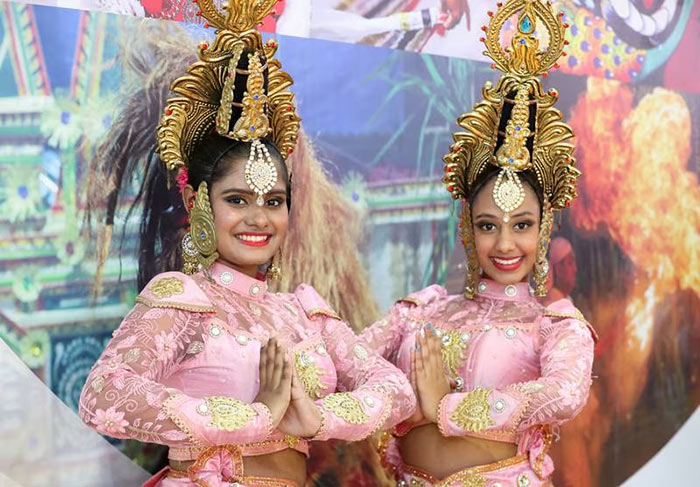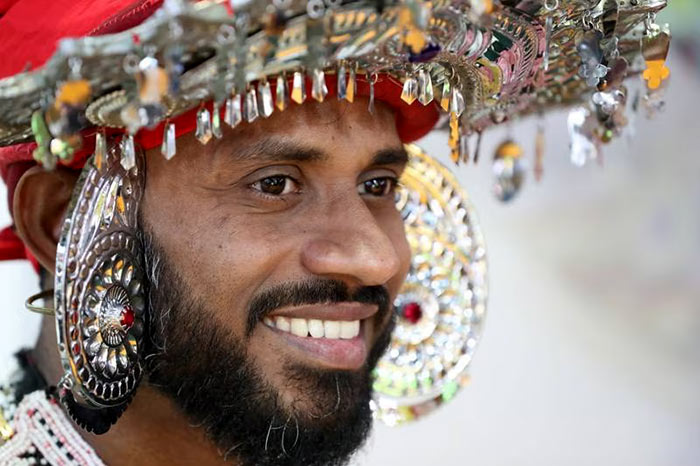Sri Lanka expects cash infusion from 1.5 million tourists in 2023 for crisis-hit economy

The Sri Lankan stand at the Arabian Travel Market in Dubai. (Chris Whiteoak / The National)
Sri Lanka expects to host 1.55 million visitors and earn 2.7 billion Sri Lankan rupees ($8.4 million) in much-needed tourism revenue this year, as it maps a road to the recovery of its tourism sector amid its worst economic crisis in decades.
This is up from the 720,000 tourists it welcomed in 2022, but still below the record 2.3 million visitors that flocked to the country in 2018, Padma Siriwardana, managing director of the Sri Lanka Tourism Promotion Bureau, told The National on Thursday on the sidelines of the Arabian Travel Market in Dubai.
The sector is on target to achieve its annual goal after receiving 450,000 visitors this year to the end of April, she said.
“We are back on track for recovery. We are coming out stronger because our industry is very resilient,” Ms Siriwardana said.
The recovery comes after the country’s tourism sector suffered several setbacks: the Easter attacks in 2019, the two-year Covid-19 pandemic and widespread street protests in 2022 in response to an unprecedented economic crisis that led to severe shortages of food, medicine, fuel, cooking gas and electricity.
Sri Lanka’s economy contracted by 8.7 per cent in 2022 and is forecast to shrink by another 3 per cent this year.
Inflation hit an average of 46.4 per cent in 2022, affecting mostly the poor and vulnerable, but is expected to come down to 28.5 per cent this year, the International Monetary Fund said.
Underpinning recovery in the tourism sector are Sri Lanka’s efforts to promote “niche” offerings to attract high-spending visitors from countries such as Japan, Ms Siriwardana said.
Beckoning tourists to the island are marine explorations to discover more than 100 shipwrecks along its coast, a 22-day hike through the mountains on its Pekoe Trail and wellness programmes.
“The post-Covid traveller is into new experiences,” she said. “We started a campaign targeting our main wellness markets, France and Germany, to promote authentic Sri Lankan wellness.”
In March, the IMF approved a $3 billion bailout loan to help the island nation of 22 million people to restructure its debt and address its crisis-hit economy.
Asked if the tourism industry will be one of the beneficiaries of the incoming funds, Ms Siriwardana said: “Part of it will be for the tourism industry. Some of the donors have committed to giving more funds for tourism investment.”
While the tourism board has sufficient funds to launch international promotional campaigns, it had difficulty last year with marketing spend abroad due to the country’s foreign currency shortage, but “now it’s definitely getting better”, she said.
The tourism board is increasingly localising the creative, marketing and public relations work it commissions so that it spends money within the country, she said.

A man appears in traditional Sri Lankan dress at the Arabian Travel Market in Dubai. (Chris Whiteoak / The National)
While the devaluation of its currency has made Sri Lanka a cheaper place to visit for tourists, the country has also worked on campaigns after last year’s protests to address concerns about its safety and stability as a tourist destination, she said.
“This is basically the recovery phase and we’re looking at negating negative perceptions,” she added.
“We are launching a mega influencer campaign called ‘Seeing is Believing’ because you have to come and see now – it’s all under control and everything is back to normal.”
Sri Lanka’s severe foreign currency crisis has made it more expensive to import basic goods. However, import restrictions for the tourism industry have been relaxed, inflation has dipped and the sector has adopted a strategy to source local produce, she said.
“Sri Lanka is very safe. We have a lot of unique authentic experiences for tourists. It’s a beautiful country – we have good weather all year round and amazing landscapes, so do visit us,” she said.
Meanwhile, national airline SriLankan, which operated under tough conditions last year amid scarce jet fuel supplies, travel advisories that curtailed tourist inflows and lack of access to funding, is now starting to soar, the airline’s chief said.
It reached break-even point in the fiscal year ended March 2023 for the first time in 15 years, Richard Nuttall, the airline’s chief executive, said at the Arabian Travel Market.
This came amid constrained capacity, travel demand from the Sri Lankan diaspora and transit traffic from the Indian market.
The airline group is expected to turn a profit in its next fiscal year as travel bans lift and jet fuel supplies normalise, he said.
The debt-laden airline as well as several other state-owned entities have been proposed for sale to raise foreign exchange and boost the country’s external reserves.
The government is keen to accelerate the airline privatisation process and aims to secure an investor by year’s end, the airline’s boss said. He declined to name interested parties, the size of the stake sale or the ownership structure.
However, there are “clear strategic benefits”, given Sri Lankan airline’s proximity to India, where it flies to 10 cities.
SriLankan issued a request for proposals earlier this year to lease used aircraft as it seeks to boost capacity in response to higher travel demand.
It is looking to lease five Airbus A320-family jets and five A330 aircraft, Mr Nuttall said. It is currently evaluating the bids received and aims to grow its fleet to 27 jets by mid-2024.
(Source: The National)
Latest Headlines in Sri Lanka
- Arjun Aloysius and two others released from prison February 22, 2025
- Two more arrested over ‘Ganemulla Sanjeewa’ assassination February 22, 2025
- Sri Lanka Police identify 58 organized crime gangs and 1,400 associates February 22, 2025
- Sri Lankan President pushes for rapid digital economy growth February 22, 2025
- Namal Rajapaksa ready to lead if government dissolves February 22, 2025


